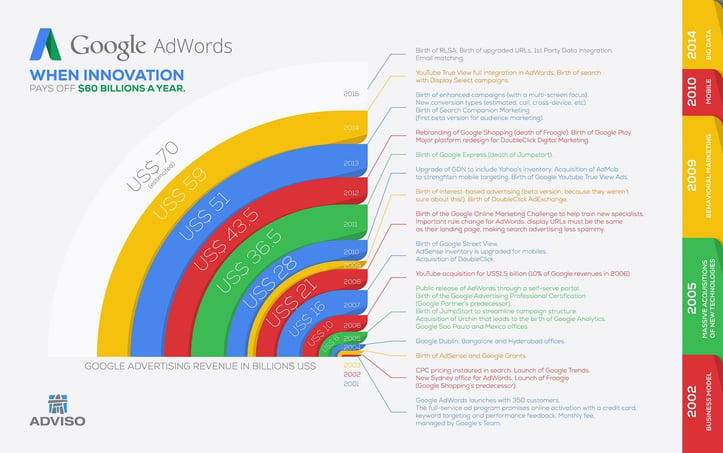Team Lead Data & Intelligence
Google Adwords: When innovation pays off $60 billions a year
Team Lead Data & Intelligence
In 1995, a 22 year old student named Larry Page considers pursuing graduate studies at Stanford. Sergey Brin, 21, greets him with a guided tour of the campus. In 1996, the two young men started working together on a research project named BlackRub, the first ever content indexing engine, which will soon take up way too much bandwidth on Stanford’s local servers. A year later, Sergey and Larry co-founded Google, thus marking the beginning of a new digital era.
Today, October 23 2015 marks the 15th anniversary of Google AdWords, Google’s index monetization platform. Fifteen years after the creation of this index that makes finding websites quick, Google now reports $60 billions in revenue annually.
Why is the Google model as strong? Were Larry and Sergey the only visionaries of the last 15 years? Of course not! I’m thinking here of an article in Les Affaires that caught my attention with its provocative headline: Why Your Great Idea Isn’t Worth Anything (Pourquoi votre idée géniale ne vaut rien, in French). In short, it’s not the value of an idea that guarantees its profitability, it’s the company’s management and the realization of the projects which is the key to success.
What characterizes Google is this innovation that is rooted in their corporate DNA and the leaders desire to acquire companies that hold an idea and a technology instead of trying to replicate it.
Three years after the foundation of the search engine, the first AdWords reps arrive in office and approach their first 350 customers. The company then sells spaces to be more visible in the index, a business model very close to the Yellow Pages.

Business model
The following year, in 2002, Google is testing a new business model, based on Overture’s, passing from CPM to CPC display. Now, an advertiser only pays when a visitor is actually interested in its ad. This will be the starting point of a fast-paced series of innovations and of an open-mindedness that would never slow down in the coming decade
Content is king
In 2003, Google realizes that content is king and creates Google AdSense, that allows any editor to generate income. This was just before the explosion of blogs popularity in 2004-2005, which would thereby become powerful social communication tools.
Massive acquisition of new technologies
In 2005, Google acquires Urchin and launches the Google AdWords public platform (self-serve). For the third time in 5 years, Google rewrites the rules of online marketing and AdWords yields a US $6 billions profit the first year.
In 2006, keeping up with its rapid innovation policy in emergent technology, Google acquires YouTube for US $1.5 billion (about 10% of its annual income). The television industry mocks this transaction. According to them, free video hosting (of cats and other cute animals, furthermore!) is not profitable. But when Google releases the YouTube Ads True View in 2010, it is approximately US $10 billions in additional income that adds to their annual revenue after 4 years of research and development and an initial investment of US $1.5 million.
In 2007, DoubleClick joins the great Google family. But the program that everyone is really talking about at that moment is Google Street View, which complements the already existing Google Maps (which is particularly interesting for those who are always late!).
The year 2007 also marks the moment when I run my first major CPC campaign for Via Rail Canada and make my debut in the world of digital advertising.
Behavioral Marketing
In 2009, Google is inspired by the BT (Behavioral Targeting) work of pioneer George John (who worked for Yahoo! and founded Rocket Fuel) and includes this revolutionary approach to behavioral marketing in its platform. They become interested in the digital information provided by Internet users, and use this information to deduce their interests: thus is born the Interest Based Advertising. Result: it is no longer necessary to target a person seeking a car specifically on a dealer website, since it is now possible to target a person anywhere in the Google Display Network because it has demonstrated its interest in buying a car through the search terms used or visited links!
Mobile
In 2010, Google invests in mobile advertising and launches its first Nexus phone. The industry is evolving rapidly and the contact points with a user once limited to PC are now spread across a multitude of devices and locations.
In 2013, Google launches Enhanced Campaigns to better serve visitors in their multidevice journey happening on their mobile, tablet, PC and laptop.
Integrating Big Data
In 2014, a short episode of madness accompanies the launch of Search Companion Marketing, which inadvertently enables the industry to compete over acquiring their competitors customers at very low cost. To remediate the situation, Google offers a version where advertisers have less competitive power against each other. Search Display Select campaigns are born, a hybrid between a display campaign based on users interests and a search retargeting campaign.
In 2015, Google invests so that data becomes the center of all campaigns, with tactics such as Remarketing List for Search Ads (RLSA), integration of 1st Party Data and Email Matching. After taking a major turn into mobile in 2010, Google continues to go with the flow of digital marketing and integrates more and more Big Data.
To support the growth of its many activities in fields that are quite different than its search engine, Google is renamed Alphabet after 17 years of existence. Alphabet thus becomes the owner of Google and all the other projects conducted by Sergey and Larry’s team.
This short overview of the evolution of Google teaches us a lesson, especially since Startup Weekend is coming up soon: don’t be afraid to embrace your ideas! Google X Lab offers one day a week to their employees so they can invest their time in developing personal projects, and this initiative led to the birth of some of Google’s major innovations and many others! As a company, invest in innovation and offer tools and time to your employees to let them explore their creativity!
For more details, visit:
http://www.google.ca/about/company/history/








